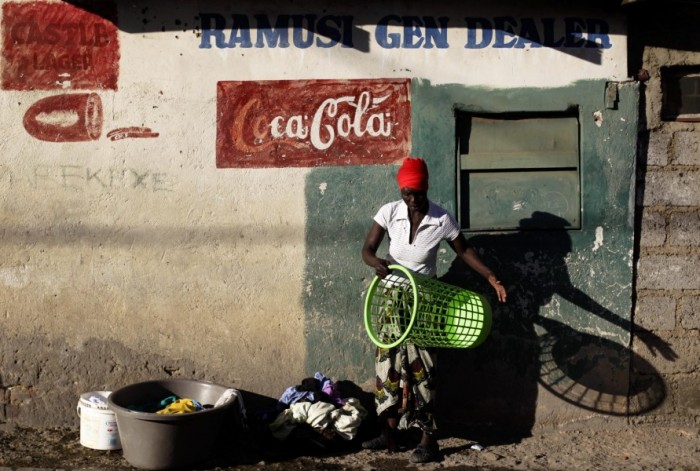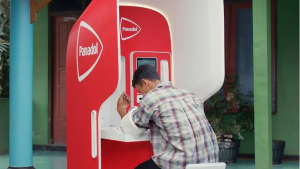Part of the Project

Kidney tables balanced on shelves, crystal glasses in wine red, saffron yellow and petrol blue glitter in showcase: Wim Castle Mans interior shop "Decade" in the heart of Johannesburg is bursting with vintage accessories from the 50s and 60s at the seams.
Further east, right across the city center, a brightly painted steel container serves as an information booth for trendy loft renovations. A camera crew filming models in trendy African-prints of fashion brand "Loin Cloth & Ashes".
Two floors above peels, meanwhile Frederick Clarke behind whitewashed walls of a former liquor factory out of bed. The 26-year-old painter and filmmaker living as the first "resident artist" in the halls of "Arts on Main" where recently - opened a branch of the German Goethe Institute - as a symbol of courageous commitment to urban renewal.
Once no-go areas, today hipster hangouts
We are the pioneers here, "says Frederick Clarke, the resident artist when he visits with his colorful showcase district Maboneng (Sotho for" Place of Light ") accompanied that with art galleries and bookshops, the Bioscape cult cinema, hip restaurants and to the living room converted commercial lofts in Brooklyn or Tribeca recalls.
In hammocks young people of all stripes swing on the roof terrace of the "Living Room"'s impressive skyline, founded in 1886 gold rush mecca.
But just like once in New York , it was not always so chic in South Africa's largest city. Worse, the entire city of Johannesburg, the powerhouse of Africa, until recently as "spectacularly failed city", says architect Gerald Garner.
Where today freshly planted trees line the streets, were ruled by drug gangs no-go-areas a few years ago. In the courtyard of the 50-story, round about Ponte Towers, one of the first skyscrapers on the continent with 495 apartments, the garbage piled up three floors. Businesses Abandoned rotten between run-down apartment block.
Yesterday Apocalypse, now hope
South Africa has, changed as a destination, in the almost twenty years since the end of apartheid enormous. Most striking is the change in the cities. Traveller favorite Cape Town is preparing for his performance as World Design Capital in 2014.
The four-million-metropolis of Johannesburg, together with Lagos in Nigeria and Nairobi in Kenya, the principal city of the continent seems the Apocalypse jumped in the last minute of the ride.
While the policy suffers from corruption, the economy, despite all efforts to the little man offers too little and the world wonders what comes after Nelson Mandela, the country invents at least culturally new. "We will never be white again, but again worth living", describes urban planning guru and bestselling author Gerald Garner the state of his home country.
Above all, "Jozi" as residents affectionately call the largest city in the country, with unusual culture corners, remakes of historical sites, lofts and hotels - almost unexpected - a new lease of life - from the Bohemian quarter Maboneng about student accommodation Braamfontein to alternative shopping arcades as "44 Stanley Ave".
"Jozi" has survived
Yet the city has a history of incredible urban decay behind: the end of the nineties the shops last had fled to the northern suburbs Sandton and Rosebank, bricked entire streets or de facto occupied, omnipresent alone the sound of police sirens.
"The city was virtually written off," says the South African architect Garner, who like no other documents the impoverishment and now tarnished rebirth.
For experts like him are now certain that the neglect was sealed before the end of apartheid: "As the sanctions intervened more and more whites left the cities, leaving many a homeowner rot his possession, other leased later 2-bedroom apartments at immigrant families with 30 people. Nobody was more concerned with maintenance, electricity and water. "
Under the pressure of hundreds of thousands of immigrants - still a taboo subject for the black government - imploded downtown. Only in 2007 the city fathers agreed on a "regeneration charter" with four columns: buses, trains, security, infrastructure. It was developed from the football World Cup of 2010.
Under the direction of the German Society for International Cooperation (GIZ) Rea Vaya emerged, a rapid bus system, with the residents for the first time in the history of South Africa safely and comfortably drive to the city center for the equivalent of just over one euro of Soweto. "But the main driver of the turnaround," says Gerald Garner, "were private initiatives".
A Brewery for tourists
The fittest 41-year-old with three-day stubble now leads tourists walking through the urban jungle, even by the famous-infamous Hillbrow. "2011 is the pendulum swung the other way," says the South African architect, even if the front of buildings with shattered windows and half hanging curtains in the troubled districts outweigh yet: "It's not all perfect, but we work on it."
What was called in America "Zero Tolerance", completed in South Africa surveillance cameras: the Inner City crime rate, the highest in the world, fell by 80 percent. But here the similarity with the New York metamorphosis hears already.
"We have finally went to a political system change," says Garner, "a simple renewal of the old structures was beyond question, because the old white Johannesburg with its swept sidewalks was an art city that nobody wants to have back."
So what instead? "Johannesburg is today South Africa's first truly diverse city," says Garner, "a start-up city like Berlin . " In downtown Newtown area, where since 2003 the curved Mandela Bridge is urban planning accents, housing for young families is promoted, presented South African brewing in the "World of Beer" tourists.
In Maboneng start-ups are preferred so to establish a "healthy mixed culture of living, working and sightseeing" Garner. "Jo'burg is now an African city and they will remain so," says the designer.
For the equivalent of 40,000 euros you can buy in Maboneng a trendy renovated 50 square meter apartment with views over the twinkling lights of the African megacity today. The price in the first location in downtown of a major world metropolis speaks volumes. "We are optimists," says the 30-year-old investor Jonathan Liebman, who has already bought other 15 city ruins, and sees himself as an "urban activists".
100,000 "economically active" new inhabitants saw the city in the last two years. 50,000 apartments have been renovated in the last five years or newly built. Vacancy rates of office declined from 40 percent to Ghost Town times in 2003 to 17 percent today down.
Adventure Park Soweto
Private investors as Liebman shape the revival of Jo'burg at all corners: the center of Soweto have recently staged as a fight for freedom-theme park, with colorful signs to Vilakazi Strett, the only street in the world with two Nobel laureates, Bishop Desmond Tutu and Nelson Mandela.
Its small township house has a glass front with reception get to channel the flow of visitors. Before the hypermodern "Sakhumzi Extension" -Cafe park red sports car with a spoiler.
Since the urban environment is "Stanley 44" clear alternative. In the former factory in Milpark eco-cafes in rustic wood design, South Africa's young elite meet for lunch. Also, trend researchers Diong Chang maintains his office here. His desire for urban regeneration: "It must be even greener."
And everywhere sets policy Accents: In "Arts on Main" entertain activists like Brendan Copstan their offices. The 33-year-old has been involved in the huge landscape sculpture of Nelson Mandela's head, which was unveiled last year.
The legacy of the freedom struggle, visitors impressively, the 2004 Afro-designed new building of the "Constitutional Court" trace between Braamfontein and Hillbrow, where the unique liberal constitution of the country is anchored. Cowhides disguise the judges tables, the active Court is freely accessible and at the same time a political Museum.
Design-Queen Cape Town
In Cape Town, which is still "whiter" presents itself as a city and less mixed than Johannesburg, the remake runs under different circumstances. Violet George sits on her bench and looking forward. But what has the nice old lady who is so happy to walk in the Woodstock area, to do with the new South Africa?
The 89-year-old colored nail was the inspiration behind the project of the South African architect Luc Petersen, folding benches against the walls of small workers' houses - to make residents as Violet's life more pleasant. Now they can rest between shopping and walk in his own front door.
Behind the Violet campaign as behind many creative ideas put Ravi Naidoo, 48 The Indian-born South Africans style guru and engine of the "Design Indaba," the world's biggest design fair that since 1995, tens of thousands in each February and Design Experts Fans moves into town between Table Mountain and the Atlantic Ocean.
A mixture of Expo conference and a festival, with furniture and clothes, film and music. Cape Town now has, which is called here prefer Cape Town, voted the World Design Capital for 2014.
Every two years, gets the top title to another city, in 2012 it was Helsinki. "Design for people, not for brands," says Ravi, "this is our idea: Anything that makes everyday life more beautiful and better."
Township Houses of sand
Design curricula for African High School Kids belong and township projects, such as the ten model houses of sandbags that were designed for a former Township in Mitchell's Plain near the Atlantic and already built. In practice test the design buildings however encounter with the inhabitants of a more critical assessment.
"There are too many and too low window", complain Mushara Anthony and his wife Kieyam living with two adult children in one of the 50 square meter detached from sand. Low windows are namely a risk of burglary in the troubled settlement with 1.5 million residents. It is well if the complicated African everyday life meets design planning.
Cape Town has taken one of the most expensive women in the world under contract to promote the design year, the former assistant of computer billionaire Bill Gates and native South African Alayne Rees Berg (50). "Design for the Road" is their motto; Design of the road is already to be found everywhere today.
On Cape Town's notorious red light strip, Long Street, compete dozens of local designer boutiques (the best: "A-List" and the vintage store "Second Time Around").
After sunset celebrates a young scene on wrought iron terraces of old colonial houses. On the roof of "Grand Daddy" sleep guests in silver "Airstream" -Wohnmobilen the 50s. Women with Aretha Franklin African serving in the cool "Julep" bar, 2 Vredenburg Lane, with retro erotica on the walls.
Markets for hippie Gourmets
Besides aufrührenden memory places like Robben Iceland, the prison island, spent much of his 27-year prison where Nelson Mandela, and a growing art and gallery market, Capetonians retake their streets.
Who authentic South African art, subtle cured, see or want to buy, go to Heidi Erdmann Gallery "Erdmann Contemporary" in the historic downtown district.
Saturdays meet on the "Neighbourgoods Market" in the in-district Woodstock. In the district with small Victorian terraced houses above the container port for young, ragtag family affordable housing, here is Cape Town slowly developed multi-cultural. Local galleries, fashion designers, cafes sit in the "Woodstock Exchange", a former industrial building.
In "Cape Quarter" Shopping Center in the newly awakened Waterkant district jazz trio playing at sunset; a combination of time offices, Boutique and Bar is where the hipster-fail "It's a house" - in itself a design prize worth.
Quite different is the "Alma Café" in Rosebank: The old hippie club with live stage was once a kiosk with shoe polish and soap; now let owners Richard and son John Mowbray top acts occur and prove: The Verve and power of alternative White dominate the new South Africa.
Aftermath of the World Cup
As in Johannesburg remodeling and new construction has changed permanently for the World Cup, the cityscape in Cape Town. A swathe of the city to the sea struck the three-kilometer-long fan mile.
The coffee bar "Prestwich Memorial" at the beginning of the pedestrian path is a Museum: bones of 6000 freed slaves and workers of the first colonial period, dug during the construction of the fan mile, here have a place of honor received.
For design-year aufrüschen again properly will the new Fringe District, near the eponymous museum of the famous "District Six", the in the 70's flat-rolled multicultural district. 60,000 people were displaced from here to 1982, in a last gasp of apartheid.
Excellent are already occupied the productions in the indie club "Fugard Theatre". And when culture fans in "Charly's Bakery" next door verschmausen the most colorful and craziest cupcakes the city, everyone agrees: In the Rainbow Nation, the future has just begun.
Getting there: South African Airways for example, flies daily from Frankfurt and Munich nonstop overnight to Johannesburg - and on to many destinations in Southern Africa (phone 069/299 803 20, www.flysaa.com ).
Information: information on South African Tourism available under www.dein-suedafrika.de and the free service number 0800/118 91 18 Current Travel Deals German organizers are available at www.dein-suedafrika.de/reiseangebote .
Participation in the tour was supported by South African Tourism. Our standards of transparency and journalistic independence, see www.axelspringer.de/unabhaengigkeit








